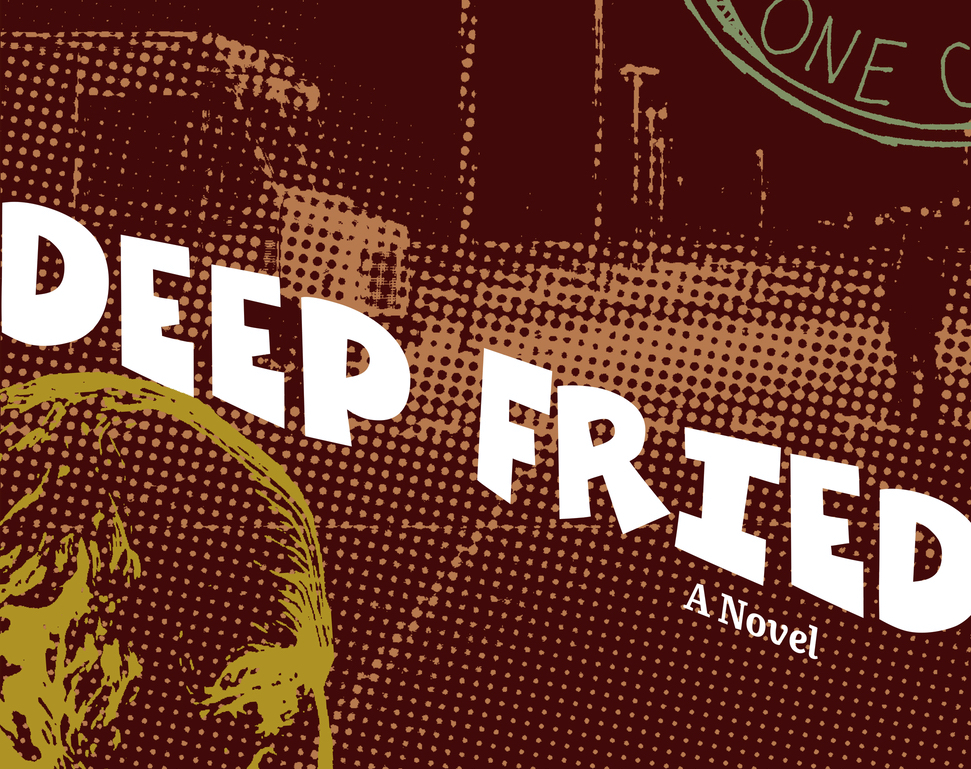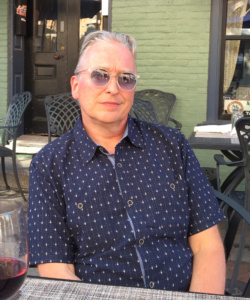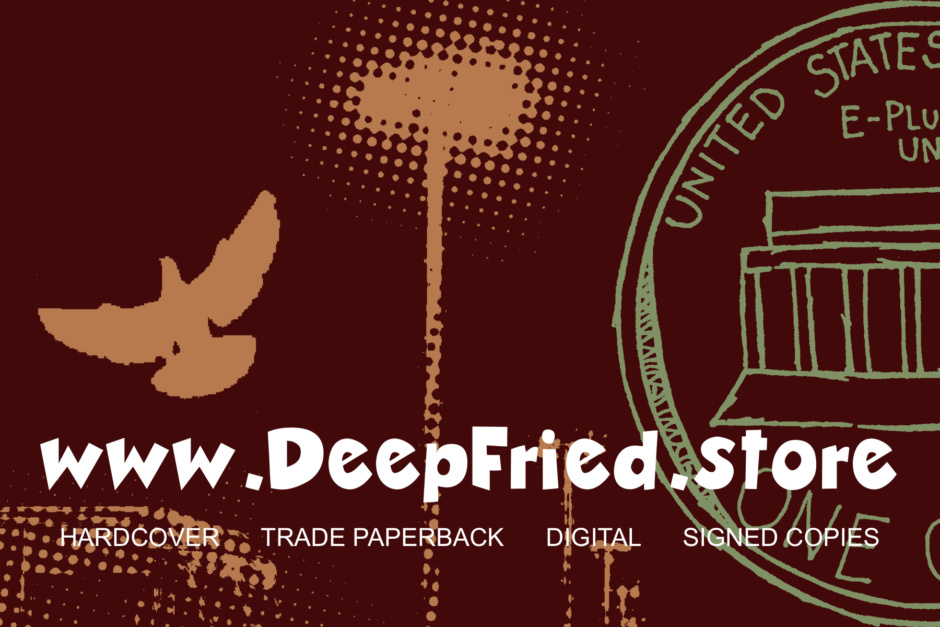‘Like a Radio’: 5 Questions about Big Dreams with Mark Doyon

Wampus denizen Kevin Kerr chatted with Mark Doyon about the role of dreams and creative freedom in Doyon’s tragicomic novel, ‘Deep Fried.’
—
[Kevin Kerr]: The desire to create and how each individual wrestles with it is a significant theme in Deep Fried. There’s a continual back-and-forth throughout the book between creating for the sake of creating and creating for the sake of making a living. I get the feeling a lot of the inspiration to explore this comes from being a longtime songwriter and recording artist, as well as a fiction writer. Do you feel like what you’ve experienced throughout your music career is one of the main drivers behind writing Deep Fried?
[Mark Doyon]: Novels and albums are more alike than different to me. Either way I’m working a theme, telling a story. Deep Fried is a kind of parable of a memoir. It’s fiction, but its essence — the people I’ve met, the artists and dreamers who seem to drop into my life at regular intervals, the absurdity of existing in the face of immutable reality — blooms in some abstract way from my experience. I’ve known a lot of people with “oversized dreams and shaky prospects,” as the book jacket says, and I love those people. I want their unwieldy dreams to keep me standing close to the edge, wondering if I will take wing and fly off the cliff — or if I will, reasonably, plummet to my death (laughs).
 [Kevin Kerr]: I’m curious about the kinds of research you did for the book. For instance, the description of the food-truck business, the details of Arjun’s cultural background, the specifics of Antwaan’s hip-hop aspirations are all authentically rendered. How did you get to the point of being comfortable that these depictions were “right”?
[Kevin Kerr]: I’m curious about the kinds of research you did for the book. For instance, the description of the food-truck business, the details of Arjun’s cultural background, the specifics of Antwaan’s hip-hop aspirations are all authentically rendered. How did you get to the point of being comfortable that these depictions were “right”?
[Mark Doyon]: I was intrigued by the food trucks in my town, seemingly always staffed by young, hard-working bootstrappers with big dreams. I got the feeling that when they parked and started cooking, it was almost a do-or-die scenario. Food trucks are the humblest rung on the ladder of restaurants, and there is little room for error, financially speaking. It reminded me of what artists go through.
To write a character, you need to know them like you know yourself or your best friends. You need to know their background and their dreams and their motives for doing everything they do. I read a lot about the cultural foundations of Arjun, who is an Indian immigrant, and Antwaan, who is an affluent kid descended from slaves. I thought about their experiences as “strangers in a strange land,” as ethnic outsiders, and sought diverse feedback on their roots and culture. I extrapolated a lot about the others — Candy, Melinda, Jared, Billy, et al — from my own experiences. I think empathy — feeling another person’s pain, knowing what makes them tick — is useful in creating authentic characters in fiction.
[Kevin Kerr]: In Deep Fried, the device of expressing different worldviews through multiple characters is used to great effect. The story basically takes place in a food-truck court, but the book has a wide-ranging outlook that gives a much broader sense of the world. It’s not the easiest thing to pull off, but it comes across as effortless in the book. Were there any particular works, literary or otherwise, that inspired you in taking this approach?
[Mark Doyon]: I wanted a super-ordinary setting for the story, and nothing is more ordinary than a parking lot. Although plenty of things “happen” in the lot, the real story takes place in the minds of the characters, where their dreams and fears inspire and terrify them into action. How big should a dream be? If it’s too big, it’s sure to fail; if it’s not big enough, it’s not much of anything to anyone but the person who has it. Each character sees the world, and the purpose of their dream, in a unique way. Each is using some form of creative freedom — culinary arts, music, software design, entrepreneurship — to transcend the mundane reality of everyday life. There are a lot of roads leading to that dreamy Mecca.
I’m drawn to colorful characters, and I wanted to populate Deep Fried with creative, driven eccentrics. Works I was thinking about included A Fan’s Notes by Frederick Exley and A Confederacy of Dunces by John Kennedy Toole, each a clinic of endearing oddballs, and the droll-but-deep novels of Nell Zink and Andrew Sean Greer. There is an underlying absurdity to the characters in those stories, a sort of cosmic pointlessness that makes their worrying and striving all the more comical. Yet we root wildly for them. Of course we do.
[Kevin Kerr]: A Lincoln penny and a George Wythe statue are sentient and provide historical perspective in the book. A thoughtful pigeon who is especially concerned about having a purpose plays a key role in the story. There’s this surreal element that feels seamlessly natural within the context of the narrative and serves to heighten the power of the story. How did you come upon this concept for the novel?
 [Mark Doyon]: The idea of a penny or statue being sentient is hilarious to me. Why wouldn’t they be sentient? Who’s to say they couldn’t be? I tire of tropes that begin and end with people knowing profound things about the universe. Seems more likely we don’t know much outside our own minds. Given the complexity of the cosmos, maybe we’re not much different from the “thoughtful pigeon.” I placed the penny, the statue, and the pigeon in a dream space I think of as “the back channel,” an extra dimension as real as the other three, but not accessible by a person’s physical senses. This dimension includes “lower” animals and inanimate objects with consciousnesses (or surprising thoughts on American history). That’s the purpose of fiction — to foist noisome and exasperating nonsense upon the unsuspecting (laughs).
[Mark Doyon]: The idea of a penny or statue being sentient is hilarious to me. Why wouldn’t they be sentient? Who’s to say they couldn’t be? I tire of tropes that begin and end with people knowing profound things about the universe. Seems more likely we don’t know much outside our own minds. Given the complexity of the cosmos, maybe we’re not much different from the “thoughtful pigeon.” I placed the penny, the statue, and the pigeon in a dream space I think of as “the back channel,” an extra dimension as real as the other three, but not accessible by a person’s physical senses. This dimension includes “lower” animals and inanimate objects with consciousnesses (or surprising thoughts on American history). That’s the purpose of fiction — to foist noisome and exasperating nonsense upon the unsuspecting (laughs).
A great thing about art is it has no formal rulebook. It isn’t contained within anyone’s wishes or expectations. A novel exists to ask questions, to confront and provoke, and hopefully to enrich and to bring pleasure. Deep Fried is an existential parable that wants you to giggle in the face of life’s uncertainties.
[Kevin Kerr]: Perhaps the main theme in the book deals with the confrontation between fate and randomness, and the struggle to grasp what we can control in our lives. It’s sometimes hard to feel that we aren’t just pawns in someone else’s game. It’s equally hard not to fear the unpredictability of things. Each character tries to manage this in their own way, but some are better equipped to deal with the consequences. I would assert there’s a fair amount of poetic justice in how the story resolves. Did you have a good idea how the book would end when you started writing it, or did the process of writing it lead you to its conclusion?
[Mark Doyon]: Making choices is like standing at the edge of a diving board. Sometimes you’re on the low board, the one the little kids use. Other times you’re on the high dive, the one that makes you nauseous just thinking about it. It’s not a question of whether you’ll slip gracefully into the water, but of whether you’ll make the dive at all. Aristotle said our choices, not chance, determine our destiny. The characters in Deep Fried decide to follow their dreams, but there are costs of doing that. Some of the characters hedge their bets to dodge the sting of failure. So, is it better to take a risk on a dream or to protect yourself from disappointment? Or is it a balancing act in which you pick your spots — and let your choices, over time, determine your destiny?
Maybe a dream is like a trip to, say… Cleveland. You haven’t been to Cleveland before, but you’re fixated on visiting. You’re thinking about it all the time. Why? Is thinking about visiting Cleveland bringing you any closer to being there? No. You have to look at a map, pack provisions, leave your house, and start shuffling toward Cleveland to have any hope of landing there. Can you even see Cleveland from where you are? No. All you see is woods and roads and a lot of things that are not Cleveland. And yet you keep walking, dreaming. And as you walk, you question the wisdom of what you’re doing — because it’s a very long walk and you’re not some fool who thinks walking all the way to Cleveland makes any sense — and you vacillate between the thrill of possibility and the dread of disappointment. That is what the characters in Deep Fried are doing. Their dreams seem humble — to sell food out of a truck, or to write ditties and play them for people — but their dreams are more powerful than anything that exists in the physical world.
How can that be? It can be because we choose not to lead lives of quiet desperation.
I didn’t know how the book would end while I was writing it. I hadn’t been to Cleveland yet. As I walked in the direction of the city, I was like a radio tuning into the staticky broadcast of some big dream: “Take a left up ahead at that big, old oak, and imagine how beautiful it will be.”
Just following the directions, really.
Mark Doyon received a B.A. in English from the College of William & Mary and a master’s in arts management from the Shenandoah Conservatory. He wrote the short-story collection ‘Bonneville Stories’ and edited the literary magazine Friction. His work has been featured in PopMatters, The Washington Post, The Daily Vault, Hybrid, Skope, The Absinthe Literary Review, 3AM Magazine, Hypebot, and Riffraf. He lives and works in the Shenandoah Valley of Virginia. ‘Deep Fried’ is his first novel.


Leave a Reply